Effect of Content and Size of Reinforcements on the Grain Evolution of Graphene-Reinforced Aluminum Matrix Composites
Abstract
:1. Introduction
2. Description of Model
- (1).
- Ignoring the influence of initial microstructure by randomly assigning grain orientation degrees to lattice cells;
- (2).
- The thickness of graphene was modeled to occupy one-cell size, to adapt to the huge scale differences in the thickness and diameter of graphene as a 2D-nanomaterial. The mass ratio of reinforcement was then calculated by the volume ratio and relative atomic mass;
- (3).
- Periodical conditions were applied at the boundaries;
- (4).
- Due to regular hexahedral lattice grids, graphene was idealize-modeled as groups of surfaces with the orientations of (1 0 0), (1 1 0) and (1 1 1), as shown in Figure 1.
3. Results and Discussion
4. Conclusions
- Content of graphene has the most significant influence on the final grain size of GRAMCs, whereas the size of graphene can influence both the morphology of reinforcements and grain size. The average grain size decreased by 48.77% when the content increased from 0.5 wt.% to 4.5 wt.% for the simulated thermal condition;
- High content of graphene leads to agglomeration and results in local defects or uneven grain morphology, which will reduce the mechanical properties. Increasing the size of graphene can reduce the total number of reinforcements and reduce the extent of agglomeration. However, larger graphene layers are more prone to self-contact and overlap;
- The content of graphene can affect the uniformity of grain distribution after heat treatment, whereas the size of graphene has little influence. When the contents of reinforcements are low, abnormal grain growth (AGG) will occur, and the frequency of grain size distribution will show multi-peak phenomenon. With the increase in graphene content, the grain size distribution becomes more uniform and compact, and the extent of AGG decreases. Compared to the case with the lowest content of graphene, the standard deviation of grain size decreases by 37.31% when the content increases to 4.5 wt.%.
Author Contributions
Funding
Conflicts of Interest
References
- Zhu, Y.W.; Murali, S.; Cai, W.W.; Li, X.S.; Suk, J.W.; Potts, J.R.; Ruoff, R.S. Graphene and graphene oxide: Synthesis, properties, and applications. Adv. Mater. 2010, 22, 3906–3924. [Google Scholar] [CrossRef] [PubMed]
- Zhu, J.Q.; Yang, Q.S.; He, X.Q.; Fu, K.K. Micro-mechanism of interfacial separation and slippage of graphene/aluminum nanolaminated composites. Nanomaterials 2018, 8, 1046. [Google Scholar] [CrossRef] [PubMed] [Green Version]
- Dixit, S.; Mahata, A.; Mahapatra, D.R.; Kailas, S.V.; Chattopadhyay, K. Multi-layer graphene reinforced aluminum—Manufacturing of high strength composite by friction stir alloying. Compos. Part B 2018, 136, 63–71. [Google Scholar] [CrossRef]
- Su, J.L.; Teng, J. Recent progress in graphene-reinforced aluminum matrix composites. Front. Mater. Sci. 2021, 15, 79–97. [Google Scholar] [CrossRef]
- Latief, F.H.; Sherif, E.M. Effects of sintering temperature and graphite addition on the mechanical properties of aluminum. J. Ind. Eng. Chem. 2012, 18, 2129–2134. [Google Scholar] [CrossRef]
- Bartolucci, S.F.; Paras, J.; Rafiee, M.A.; Rafiee, J.; Lee, S.; Kapoor, D.; Koratkar, N. Graphene-aluminum nanocomposites. Mater. Sci. Eng. A 2011, 528, 7933–7937. [Google Scholar] [CrossRef]
- Khodabakhshi, F.; Nosko, M.; Gerlich, A.P. Effects of graphene nano-platelets (GNPs) on the microstructural characteristics and textural development of an Al-Mg alloy during friction-stir processing. Surf. Coat. Technol. 2018, 335, 288–305. [Google Scholar] [CrossRef]
- Brodova, I.G.; Petrova, A.N.; Shirinkina, I.G.; Rasposienko, D.Y.; Yolshina, L.A.; Muradymov, R.V.; Razorenov, S.V.; Shorokhov, E.V. Mechanical properties of submicrocrystalline aluminium matrix composites reinforced by “in situ” graphene through severe plastic deformation processes. J. Alloys Compd. 2020, 859, 158387. [Google Scholar] [CrossRef]
- Xie, Y.M.; Meng, X.C.; Huang, Y.X.; Li, J.C.; Cao, J. Deformation-driven metallurgy of graphene nanoplatelets reinforced aluminum composite for the balance between strength and ductility. Compos. Part B 2019, 177, 107413. [Google Scholar] [CrossRef]
- Pérez-Bustamante, R.; Bolaños-Morales, D.; Bonilla-Martínez, J.; Estrada-Guel, I.; Martínez-Sánchez, R. Microstructural and hardness behavior of graphene-nanoplatelets/aluminum composites synthesized by mechanical alloying. J. Alloys Compd. 2014, 615, 578–582. [Google Scholar] [CrossRef]
- Ovid’ko, I.A.; Raliev, R.Z.; Zhu, Y.T. Review on superior strength and enhanced ductility of metallic nanomaterials. Prog. Mater. Sci. 2018, 94, 462–540. [Google Scholar] [CrossRef]
- Wang, L.X.; Fang, G.; Qian, L.Y. Modeling of dynamic recrystallization of magnesium alloy using cellular automata considering initial topology of grains. Mater. Sci. Eng. A 2018, 711, 268–283. [Google Scholar] [CrossRef]
- Zhang, Z.; Wu, Q.; Grujicic, M.; Wan, Z.Y. Monte Carlo simulation of grain growth and welding zones in friction stir welding of AA6082-T6. J. Mater. Sci. 2015, 51, 1882–1895. [Google Scholar] [CrossRef]
- Vertyagina, Y.; Mahfouf, M. A 3D cellular automata model of the abnormal grain growth in austenite. J. Mater. Sci. 2014, 50, 745–754. [Google Scholar] [CrossRef]
- Wu, Q.; Zhang, Z. Precipitation induced grain growth simulation of friction stir welded AA6082-T6. J. Mater. Eng. Perform. 2017, 26, 2179–2189. [Google Scholar] [CrossRef]
- Gong, F.; Duong, H.M.; Papavassiliou, D.V. Review of recent developments on using an off-lattice Monte Carlo approach to predict the effective thermal conductivity of composite systems with complex structures. Nanomaterials 2016, 6, 142. [Google Scholar] [CrossRef] [Green Version]
- Soucail, M.; Messina, R.; Cosnuau, A.; Kubin, L.P. Monte carlo simulation of zener pinning in two dimensions. Mater. Sci. Eng. A 1999, 271, 1–7. [Google Scholar] [CrossRef]
- Gao, J.H.; Thompson, R.G.; Patterson, B.R. Computer simulation of grain growth with second phase particle pinning. Acta Mater. 1997, 45, 3653–3658. [Google Scholar] [CrossRef]
- Li, Z.Q.; Wang, J.S.; Huang, H.B. Influence of particle fractions on second-phase particles pinning grain coarsening processes. J. Mater. Sci. 2020, 55, 3434–3449. [Google Scholar] [CrossRef]
- Li, Z.Q.; Wang, J.S.; Huang, H.B. Influences of grain/particle interfacial energies on second-phase particle pinning grain coarsening of polycrystalline. J. Alloys Compd. 2020, 818, 152848. [Google Scholar] [CrossRef]
- Han, F.B.; Tang, B.; Kou, H.C.; Li, J.S.; Feng, Y. Cellular automata simulations of grain growth in the presence of second-phase particles. Model. Simul. Mater. Sci. Eng. 2015, 13, 065101. [Google Scholar] [CrossRef]
- Chang, K.; Feng, W.M.; Chen, L.Q. Effect of second-phase particle morphology on grain growth kinetics. Acta Mater. 2009, 57, 5229–5236. [Google Scholar] [CrossRef]
- Chang, K.; Kwon, J.; Rhee, C.K. Role of second-phase particle morphology on 3D grain growth: A phase-field approach. Comput. Mater. Sci. 2016, 124, 438–443. [Google Scholar] [CrossRef]
- Du, L.F.; Yang, S.M.; Zhang, P.; Du, H.L. Pinning effect of different shape second-phase particles on grain growth in polycrystalline: Numerical and analytical investigations. Compos. Interfaces 2018, 25, 357–368. [Google Scholar] [CrossRef]
- Sista, S.; Yang, Z.; Debroy, T. Three-dimensional Monte Carlo simulation of grain growth in the heat-affected zone of a 2.25Cr-1Mo steel weld. Metall. Mater. Trans. B 2000, 31, 529–536. [Google Scholar] [CrossRef]
- Gao, J.H.; Thompson, R.G. Real time-temperature models for monte carlo simulations of normal grain growth. Acta Mater. 1996, 44, 4565–4570. [Google Scholar] [CrossRef]
- Wu, Q.; Li, J.N.; Long, L.C.; Liu, L.A. Simulating the effect of temperature gradient on grain growth of 6061-T6 aluminum alloy via Monte Carlo Potts algorithm. CMES-Comput. Modeling Eng. Sci. 2021, 129, 99–116. [Google Scholar] [CrossRef]
- Khan, M.; Din, R.U.; Wadood, A.; Syed, W.H.; Akhtar, S.; Aune, R.E. Effect of graphene nanoplatelets on the physical and mechanical properties of Al6061 in fabricated and T6 thermal conditions. J. Alloys Compd. 2019, 790, 1076–1091. [Google Scholar] [CrossRef]
- Jin, P.; Sun, C.F.; Zhou, C.Y.; Shi, L.; Liu, C. Effect of SiC particle size on structures and properties of Ni-SiC nanocomposites deposited by magnetic pulse electrodeposition technology. Ceram. Int. 2019, 45, 20155–20164. [Google Scholar] [CrossRef]
- Porwal, H.; Saggar, R.; Tatarko, P.; Grasso, S.; Saunders, T.; Dlouhý, I.; Reece, M.J. Effect of lateral size of graphene nano-sheets on the mechanical properties and machinability of alumina nano-composites. Ceram. Int. 2016, 42, 7533–7542. [Google Scholar] [CrossRef]
- Hau, T.V.; Trinh, P.V.; Nam, N.P.H.; Tu, N.V.; Lam, V.D.; Phuong, D.D.; Minh, P.N.; Thang, B.H. Electrodeposited nickel-graphene nanocomposite coating: Effect of graphene nanoplatelet size on its microstructure and hardness. RSC Adv. 2020, 10, 22080. [Google Scholar]
- Zhao, Z.Y.; Bai, P.K.; Du, W.B.; Liu, B.; Pan, D.; Das, R.; Liu, C.T.; Guo, Z.H. An overview of graphene and its derivatives reinforced metal matrix composites: Preparation, properties and applications. Carbon 2020, 170, 302–326. [Google Scholar] [CrossRef]
- Agnoli, A.; Bozzolo, N.; Logé, R.; Franchet, J.M.; Laigo, J.; Bernacki, M. Development of a level set methodology to simulate grain growth in the presence of real secondary phase particles and stored energy-Application to a nickel-base superalloy. Comput. Mater. Sci. 2014, 89, 233–241. [Google Scholar] [CrossRef]
- Mohammed, A.S.; Alahmari, T.S.; Laoui, T.; Hakeem, A.S.; Patel, F. Mechanical and thermal evaluation of aluminum hybrid nanocomposite reinforced with alumina and graphene oxide. Nanomaterials 2021, 11, 1225. [Google Scholar] [CrossRef]
- Yu, Z.H.; Yang, W.S.; Zhou, C.; Zhang, N.B.; Chao, Z.L.; Liu, H.; Cao, Y.F.; Sun, Y.; Shao, P.Z.; Wu, G.H. Effect of ball milling time on graphene nanosheets reinforced Al6063 composite fabricated by pressure infiltration method. Carbon 2019, 141, 25–39. [Google Scholar] [CrossRef]
- Azar, M.H.; Sadri, B.; Nemati, A.; Angizi, S.; Shaeri, M.H.; Minárik, P.; Veselý, J.; Djavanroodi, F. Investigating the microstructure and mechanical properties of aluminum-matrix reinforced-graphene nanosheet composites fabricated by mechanical milling and equal-channel angular pressing. Nanomaterials 2019, 9, 1070. [Google Scholar] [CrossRef] [PubMed] [Green Version]
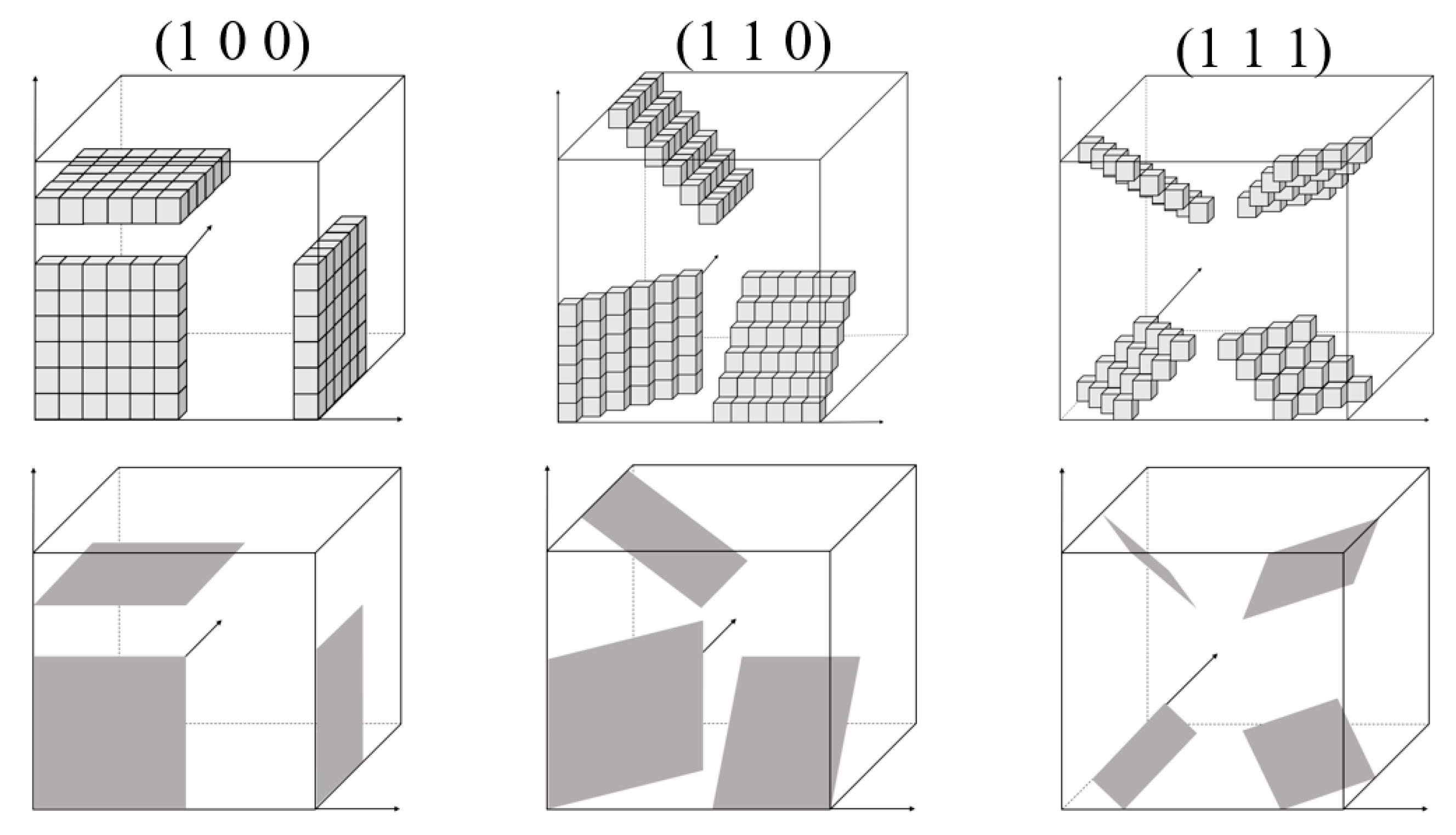
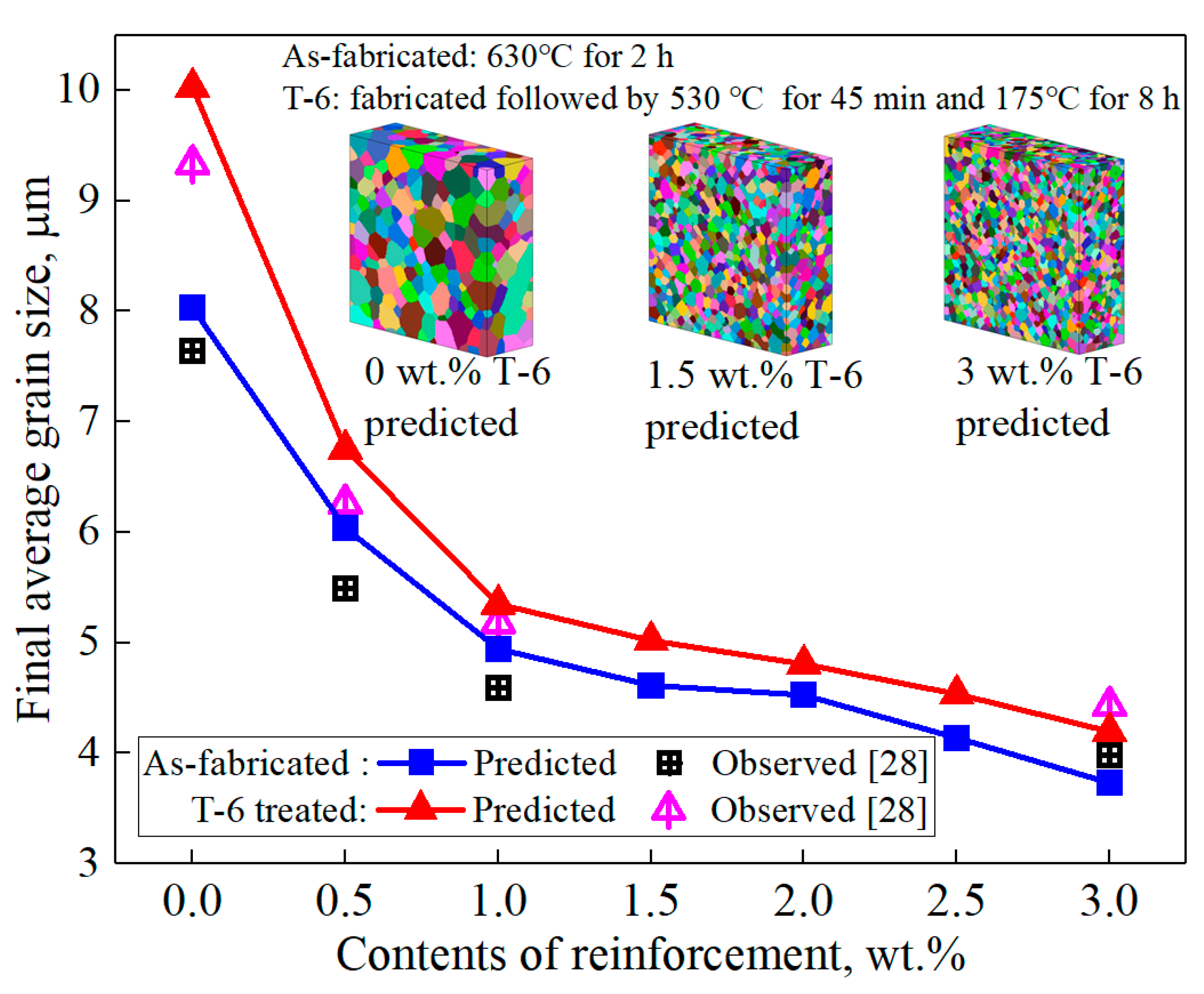
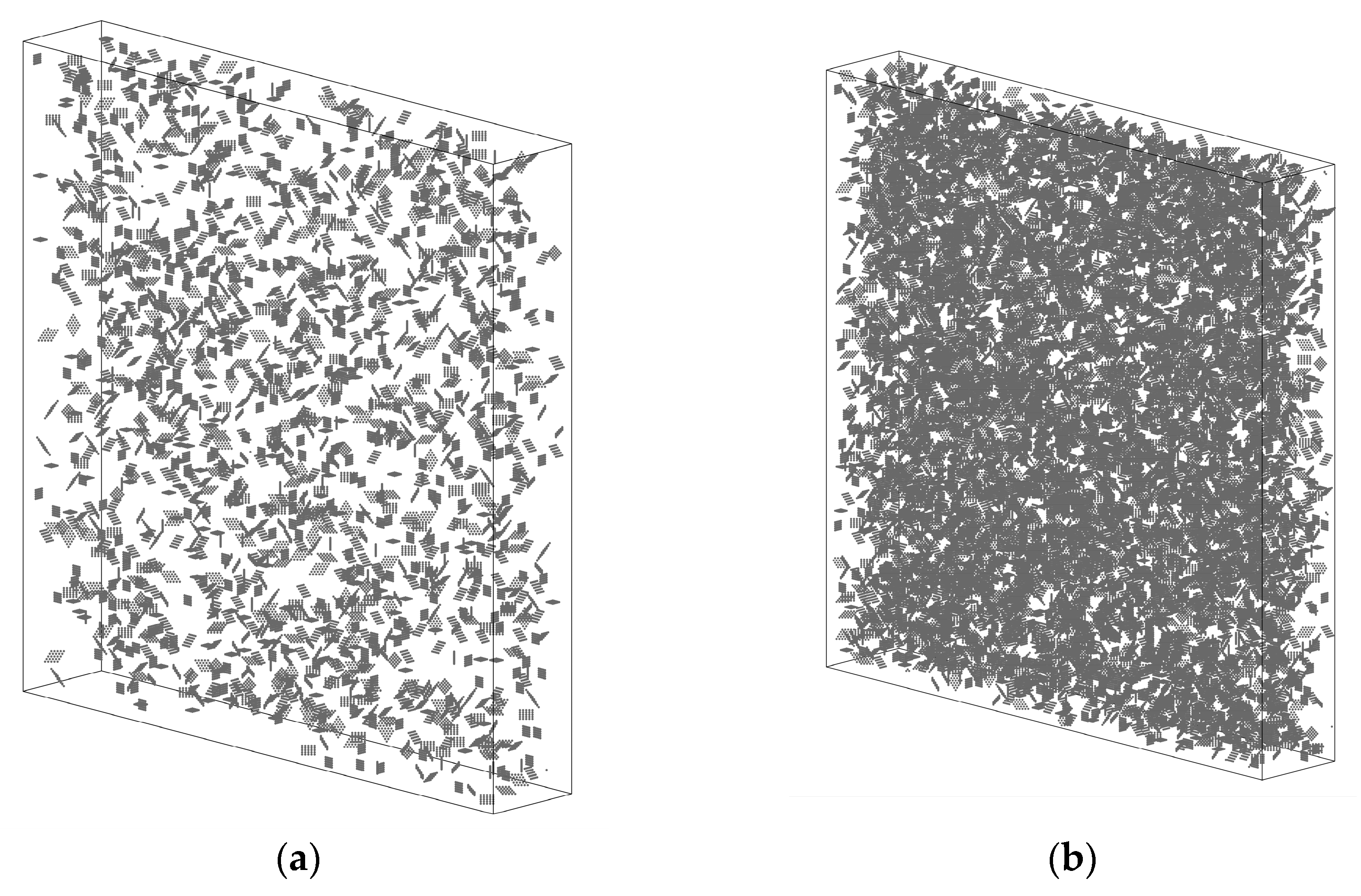


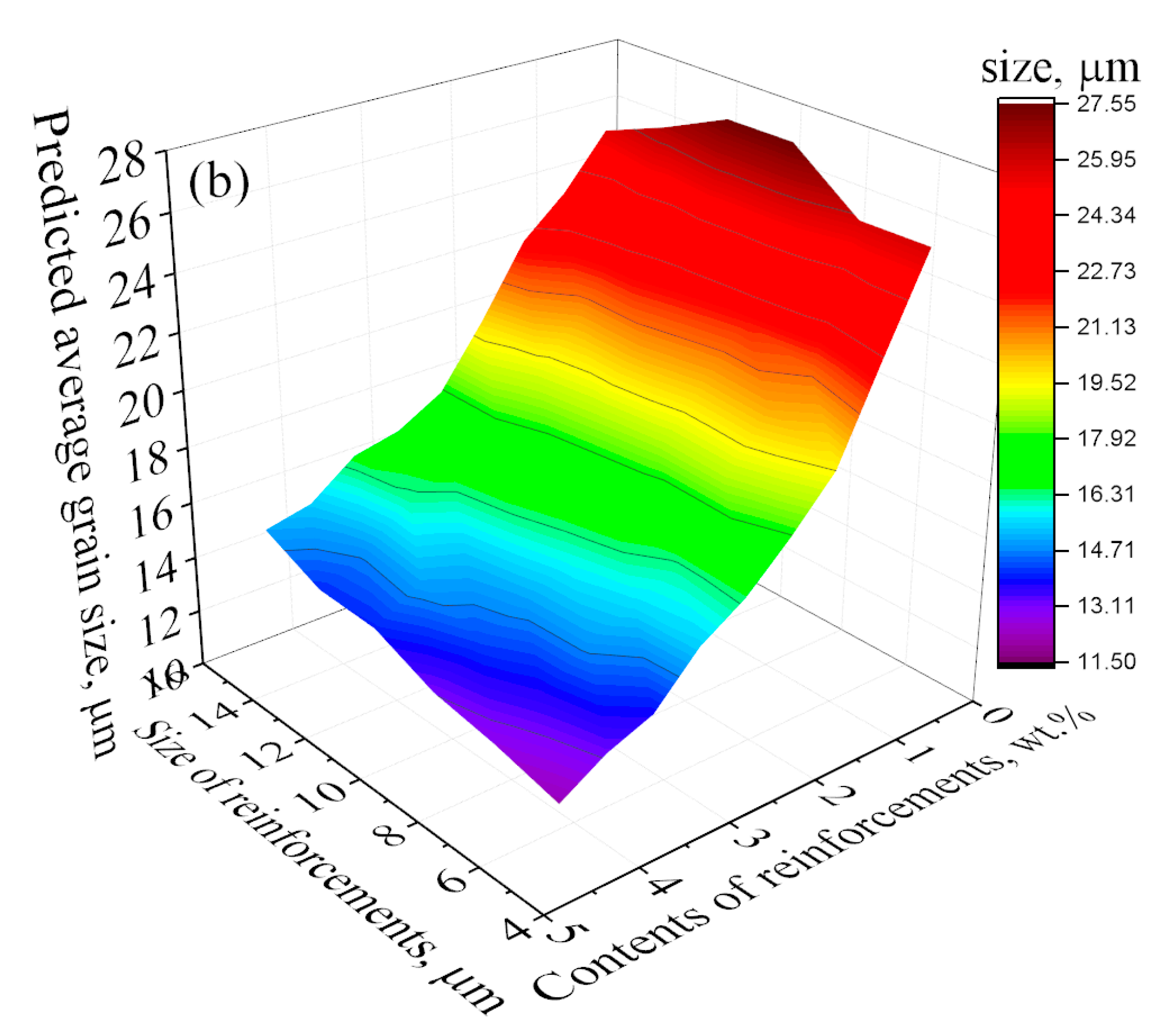
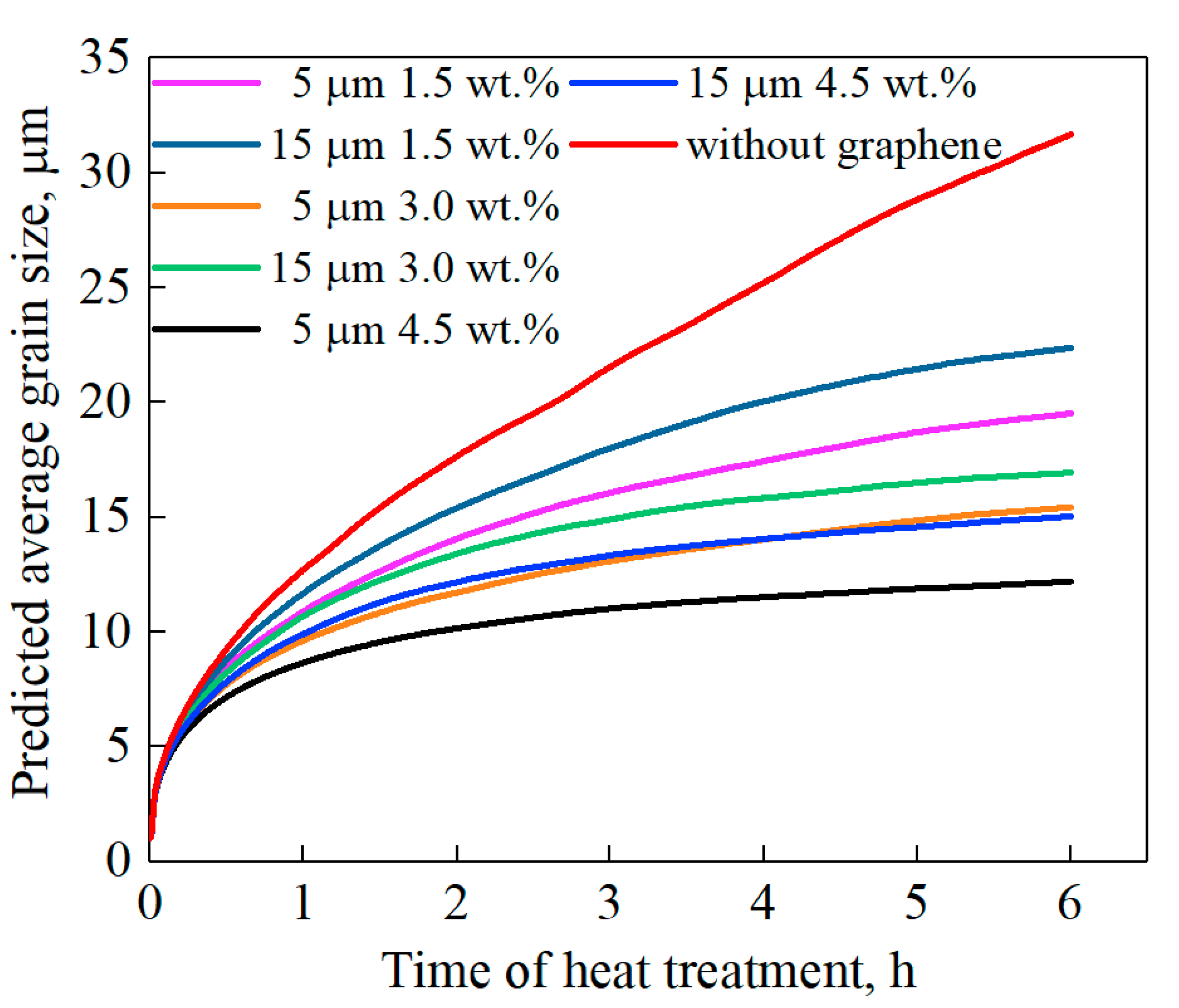

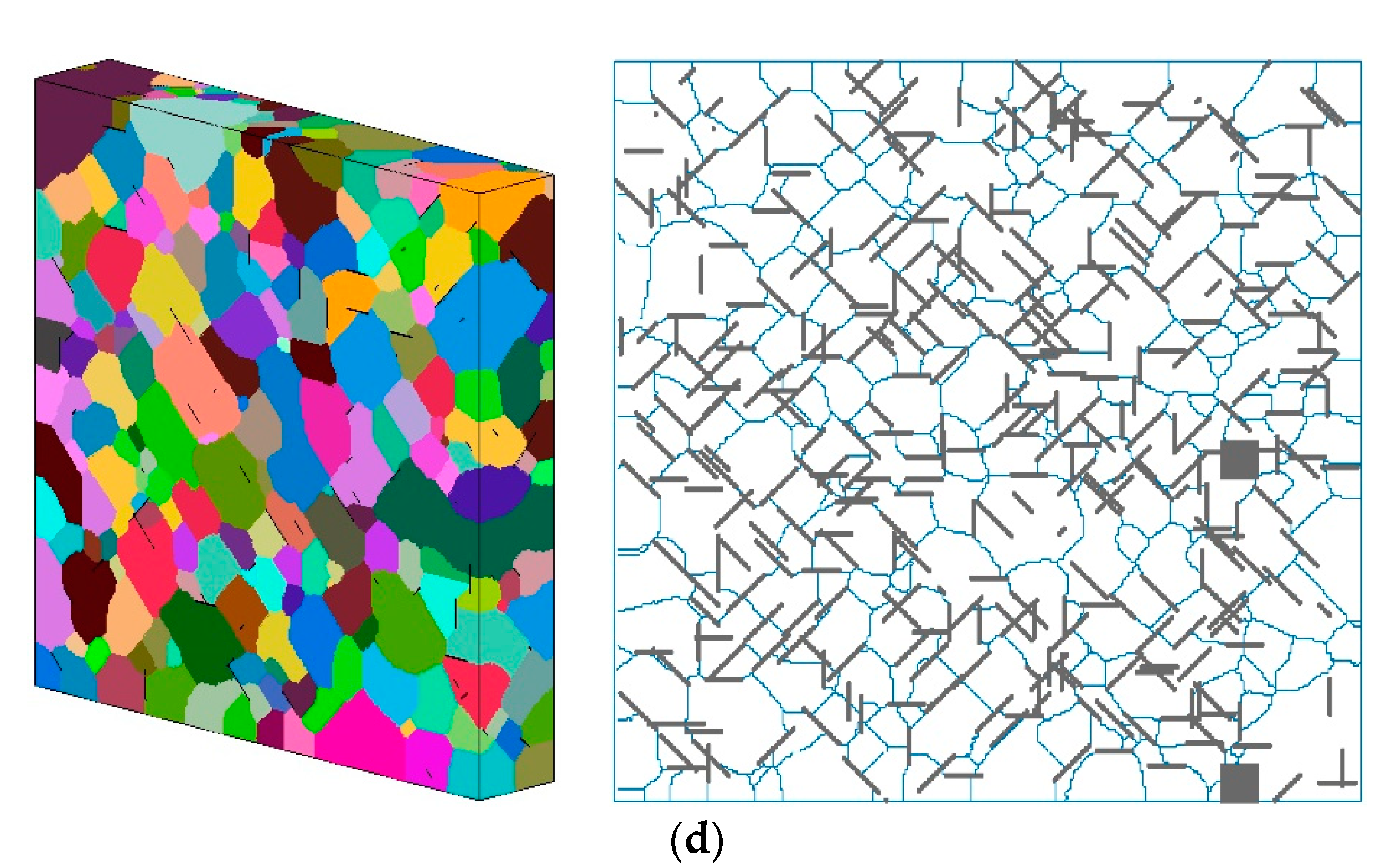
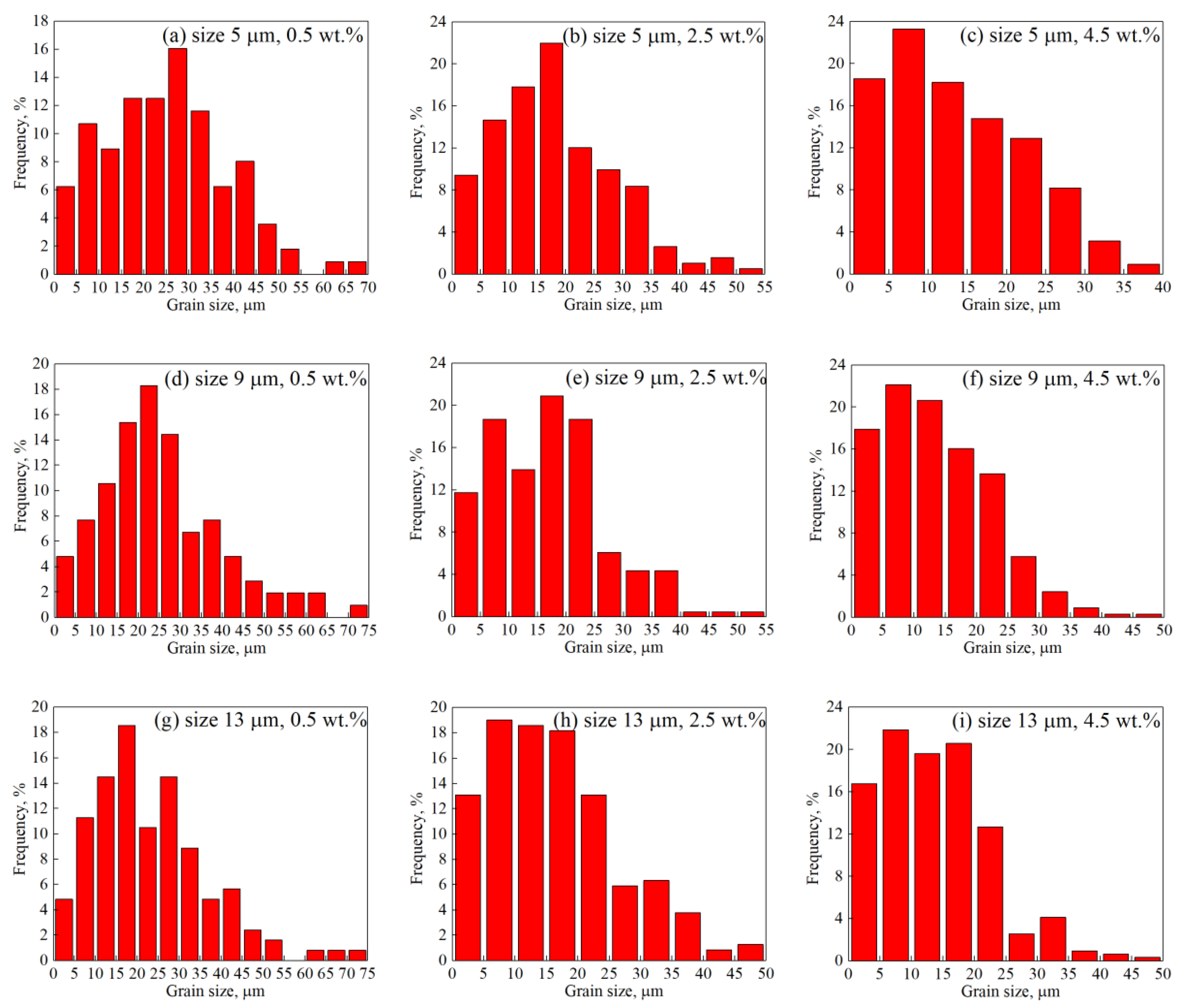
| Parameter | Value |
|---|---|
| Average number per unit area, Z | 4.31 × 1020 m−2 |
| Planck’s constant, h | 6.624 × 10−34 J·s |
| Accommodation probability, A | 1.0 |
| Gas constant, R | 8.31 J·mol−1·K−1 |
| Avogadro’s number, Na | 6.02 × 1023·mol−1 |
| Atom molar volume, Vm | 1.0 × 10−5 m3·mol−1 |
| Fusion entropy, ∆Sf | 11.5 J·mol−1·K−1 |
| Boundary energy, γ | 0.5 J·m−2 |
| Activation enthalpy, Q | 146 kJ·mol−1 |
Publisher’s Note: MDPI stays neutral with regard to jurisdictional claims in published maps and institutional affiliations. |
© 2021 by the authors. Licensee MDPI, Basel, Switzerland. This article is an open access article distributed under the terms and conditions of the Creative Commons Attribution (CC BY) license (https://creativecommons.org/licenses/by/4.0/).
Share and Cite
Wu, Q.; Cai, P.; Long, L. Effect of Content and Size of Reinforcements on the Grain Evolution of Graphene-Reinforced Aluminum Matrix Composites. Nanomaterials 2021, 11, 2550. https://doi.org/10.3390/nano11102550
Wu Q, Cai P, Long L. Effect of Content and Size of Reinforcements on the Grain Evolution of Graphene-Reinforced Aluminum Matrix Composites. Nanomaterials. 2021; 11(10):2550. https://doi.org/10.3390/nano11102550
Chicago/Turabian StyleWu, Qi, Pengfei Cai, and Lianchun Long. 2021. "Effect of Content and Size of Reinforcements on the Grain Evolution of Graphene-Reinforced Aluminum Matrix Composites" Nanomaterials 11, no. 10: 2550. https://doi.org/10.3390/nano11102550






